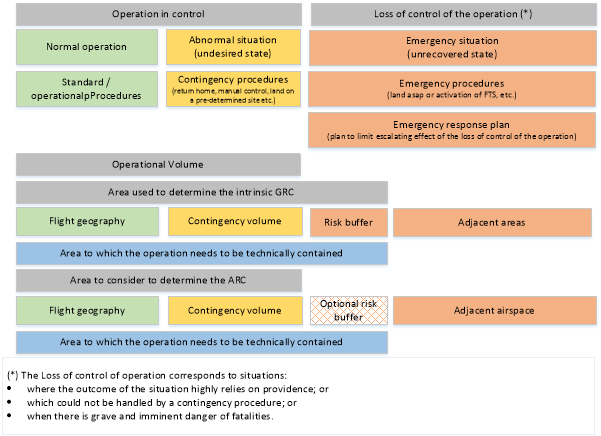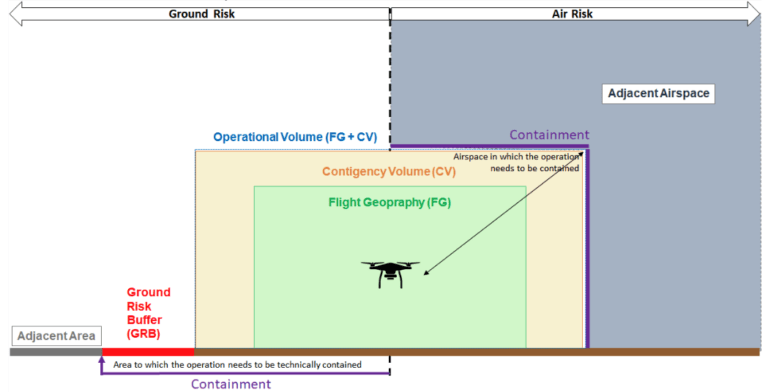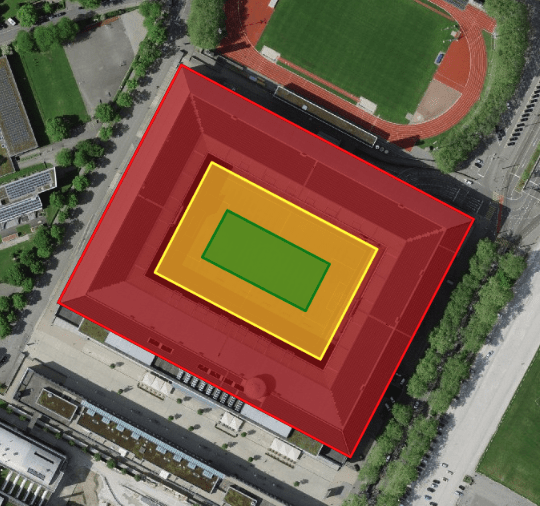BLOG POSTS
SORA Success: Tips for Understanding Flight Geography
In the world of drone operations, safety is a fundamental priority. The SORA semantic model is an essential framework in which operations are classified into two categories: Controlled Operations and Uncontrolled Operations. But what does this mean and how are these categories applied in the field?
In this article, we will break down each of the zones that must be defined and analysed before each flight, taking into account all the peculiarities of the flight. We will also explore how these zones can be adapted to specific situations, such as flying in a stadium.
Types of operations
The following image shows the two types of situations that can be found, the procedures that must be followed, and the zones in which they must be applied:

Controlled Operations
Within this type of controlled operations, we can find two types of situations:
- Normal operations
- Abnormal operations
Normal operations
These are situations in which the flight situation is normal, and normal operator procedures are applied. This type of normal situation occurs within the Flight Geography and is what we should encounter and always try to have.
Abnormal operations
In this case, the aircraft may have left the Flight Geography and entered the Contingency Volume. What should be done is to apply contingency procedures to be able to return the aircraft to the flight zone of the Flight Geography. It is important to note that the pilot does not lose control of the aircraft, but it has “escaped” from its flight zone. There are also other situations in which abnormal situations are generated, and contingency measures must be applied. For example, we could be flying in the Flight Geography and suddenly see that a person has accessed the flight area. In this case, the corresponding procedure must be applied to contain the situation safely.
Uncontrolled Operations
This situation is the most complex of all. In this case, the pilot has no control over the aircraft and must apply emergency procedures. These procedures must be applied as quickly as possible, as each passing second may mean that the aircraft moves further away from the pilot, thereby increasing the risks of the operation.
Normally, this type of situation occurs beyond the Operational Volume, within the containment buffers, both in the air and on the ground. To simplify it, we could say that the pilot previously tried to prevent the aircraft from escaping by applying contingency procedures within the Contingency Volume, but failing to do so, emergency procedures must be applied since it is considered that the pilot has no control over the aircraft.
Emergency procedures must ensure that the aircraft will not exceed the safety buffers and access the corresponding adjacent areas.
Definition of flight areas
In the following image, the different areas that must be analyzed and defined before each operation can be seen:

Operational Volume
The Operational Volume is defined as the volume where operations are carried out safely. The Operational Volume includes both the Flight Geography and the Contingency Volume.
Flight Geography
The Flight Geography is the volume where the operator is carrying out the aircraft operation under normal conditions. Depending on the type of operation that is intended to be carried out, this can be in the form of a trajectory or defined as a large volume.
Contingency Volume
To correctly determine the Contingency Volume, it will be necessary to know both the peculiarities of the aircraft to be used and the procedures that the pilot must follow to be able to move the aircraft to the Flight Geography. For example:
- GNSS accuracy
- Pilots’ reaction times
- Aircraft reaction speed
It is important to emphasize that an aircraft in the Contingency Volume is considered controlled, although an abnormal situation is occurring.
Ground Risk Buffer
To define the size of the Ground Risk Buffer correctly, it must be taken into account that the size of this buffer allows the operator to end the flight and crash without third parties being in the area. For this, aspects such as:
- Activation time of emergency procedures
- The distance the aircraft can travel falling with a parachute
- The maximum tailwind that the aircraft can have to prevent it from moving further away
- The type of aircraft (if it is a fixed-wing, possibly the Ground Risk Buffer should be larger).
Adjacent Area
In this area, the risk that we may encounter beyond the volumes described above must be analyzed. We can find two possibilities:
- The risk in the Adjacent Area is lower than that found in the Operational Volume
- The risk in the Adjacent Area is higher than that found in the Operational Volume
In cases where the risk is higher in the Adjacent Area, an improved containment must be applied, while in cases where the risk is not higher, a basic containment will be sufficient.
For example, improved containment would be necessary in cases where the following are found in the Adjacent Area:
- Airports or heliports
- Concentrations of people
- Urban areas
Practical case
In the following image (source: FOCA-UAS-GM-Part1), the delimitation of the different areas that were defined above can be clearly seen. In this case, it is about determining a flight zone within a sports stadium, where the different zones are delimited for the safe development of the operation.

We will start with the Operational Volume, formed by the Flight Geography and the Contingency Volume:
Flight Geography
It is the green zone. As previously defined, it is the zone in which the flight has been planned. Normal Procedures will be applied in it.
Contingency Volume
It is the yellow zone. As previously defined, it is the zone that has been established as a contingency zone. In this zone, Abnormal procedures will be applied to return the aircraft to the flight zone of the Flight Geography.
Outside the Operational Volume, we find the safety buffers:
Ground risk buffer
It is the red zone. Emergency procedures will be applied at this point to end the aircraft flight. In this image, it is clear how it will always be avoided for the aircraft to leave the stadium and cause harm to third parties who are on the street.
Conclusions
On the other hand, we will find situations in which the Flight Geography will determine the contingency and emergency zones, allowing them to be expanded as much as necessary. This could occur in areas where there is not much risk, such as flights in rural areas, where we can define larger zones.